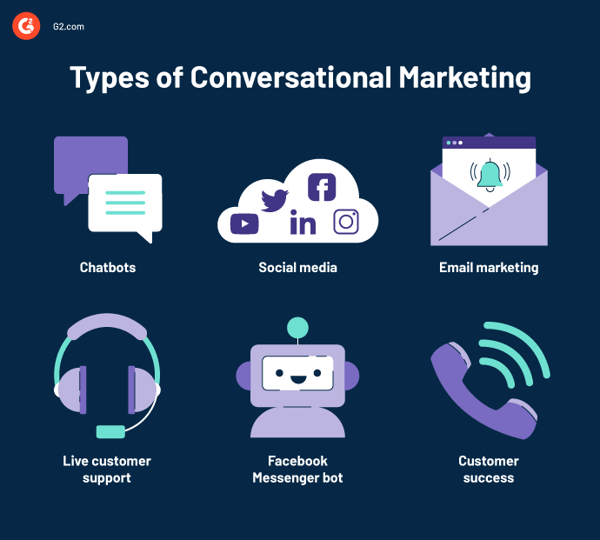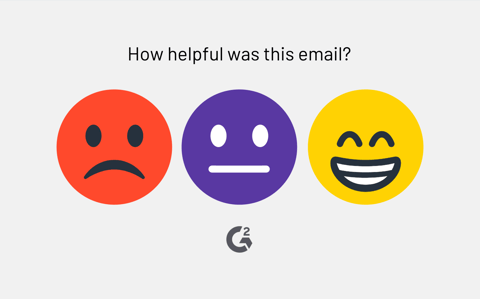October 17, 2025
 by Yashwathy Marudhachalam / October 17, 2025
by Yashwathy Marudhachalam / October 17, 2025

Communication creates communities.
When connecting with customers, businesses must remember that communication is dialogue, not monologue. It’s a two-way street that requires input from both parties. And conversational marketing is one such powerful solution that can drive this interaction flawlessly, even on a large scale.
With conversational marketing software, businesses personalize the buyer journey, identify interested buyers on different platforms, address their concerns, and direct them to the right sales rep or product page to finalize the purchase.
Conversational marketing is a real-time dialogue-driven approach businesses use to shorten the sales cycle, learn about customers, and create a human buying experience. It engages an audience with a feedback-oriented strategy that increases customer loyalty, customer base, engagement, and revenue.
Conversational marketing is all about bringing together human practices with technology. Feedback is the backbone of this approach. It fuels the process and helps companies to tailor their marketing strategy to customer needs.
At the heart of every good marketing strategy is communication. Technology has helped conversational marketing land a secure spot as a reliable marketing strategy for websites, social media, and email.
One of conversational marketing's main drivers is artificial intelligence (AI). AI in customer service is expensive, but most marketers are familiar with chatbot software.
Social media has become the norm when it comes to marketing. Potential customers are online daily, and even though they may not be intentionally shopping, a chatbot increases the chance that they’ll enquire about your product.
Modern buyers don’t wait. In an era of instant gratification and personalized digital experiences, businesses that rely solely on traditional, one-way marketing risk losing ground. Conversational marketing addresses this head-on, meeting customers where they are, when they want, and how they prefer to communicate. But it’s more than just a chatbot on your homepage; it’s a scalable strategy that aligns with evolving buyer expectations, leverages modern technology, and drives measurable business outcomes.
Here’s why investing in conversational marketing today is no longer optional, it’s strategic.
Today’s customers expect more than content; they expect conversations. According to Salesforce, 72% of B2B buyers expect companies to personalize communications based on their needs. Moreover, 70% of consumers now expect websites to offer live chat support. These expectations aren’t just preferences; they’re standards. If your brand isn’t accessible through quick, human-like interactions, you may be outpaced by competitors who are.
Bots are more than just glorified customer service representatives. They serve as the first point of contact for customers. Bots can either go above and beyond to delight a potential buyer or, when done wrong, they can deter them from purchasing altogether.
The rise of AI-powered tools has made real-time, personalized conversations easier than ever to scale. Chatbots today do far more than answer FAQs; they pre-qualify leads, recommend products, and even book meetings. In fact, chatbots can resolve up to 90% of routine customer inquiries without human intervention, saving both time and resources. Combined with integrations into CRMs and messaging platforms like WhatsApp and Facebook Messenger, conversational tools are no longer experimental; they’re essential.
The performance uplift from conversational marketing is clear. A recent survey showed that 77% of companies using conversational tools saw an increase in lead conversions. This improvement reflects the value of real-time, personalized interactions, helping move prospects through the funnel faster and more efficiently. These aren’t marginal gains; they’re meaningful, bottom-line results driven by smarter, more responsive engagement.
Conversational marketing doesn’t just benefit customers; it improves operational efficiency and sales velocity. Real-time interactions mean faster lead qualification, shorter sales cycles, and fewer abandoned touchpoints. And because much of it can be automated, it scales without requiring a 1:1 increase in headcount. According to industry data, companies that implement conversational marketing strategies have seen up to a 20% increase in revenue growth.
People associate customer service with a formulaic question-and-answer conversation that usually doesn’t satisfy the customer and the business. AI technology can reinvent how we communicate and collect valuable data that can help improve future customer engagement.
Meanwhile, for brands that deploy live chat or real‑time messaging options, the payoff can be significant: one study found that 63 % of consumers are more likely to return to a website that offers live chat support.
For example, Away has a chatbot on its website’s homepage, ready to chat if a potential customer has questions.

On the other hand, a company can only know how to improve its product or service with the feedback of its consumers. Companies can tune into what consumers say by checking their social media accounts.
When a marketing team posts on social media, they should keep up with their analytics (such as Facebook Analytics, Instagram Insights, and Twitter Analytics) to keep tabs on their audience's buying habits and interests.
When done right, conversational marketing can help businesses establish themselves in a highly competitive marketplace. Take a look at some of its benefits below:
Conversational marketing is one of the best ways to learn what your customers like and dislike. You hear from them directly, allowing you to gain valuable insights at a large scale, which can then be used to improve your products, processes, customer interactions, and content.
With conversational marketing, businesses can reach their audiences on different channels and give them a faster way to contact you. Providing authentic experiences with a human touch, constantly aiming to improve, will help build robust customer relationships.
Marketing and sales work together with conversational marketing. This integration allows for higher conversions, which means customers can move down the sales funnel faster. For instance, chatbots can send qualified leads to sales agents directly or book meetings in real-time.
Enabling one-on-one interactions with your customers gives them direct access to your information panel through interactive mediums. The more personalized your experience is, the more likely customers will engage with your communication channels.
“Conversational marketing lets you design end-to-end conversational experiences that quite literally invite customers to start a conversation with your brand and find out about your product.”
Paul Lalonde
Product Expert, Zendesk
It’s tempting to say, “We already post on social media, respond to comments, and use chat features, so we’re doing conversational marketing.” While those are part of the puzzle, truly effective conversational marketing stands out because it goes beyond surface‑level interaction. It’s built around real‑time dialogue, personalization, and seamless connection. Below are the core elements that make it successful, and how they play out in practice.
Rather than forcing prospects into your preferred channels, conversational marketing works best when you engage visitors on the platforms they’re already using. For example, if your audience live‑chats on Facebook Messenger or WhatsApp, then having a bot or live‑agent setup there helps reduce friction. Research shows that 70% of customers expect a live chat option on a website.
Example: An e-commerce brand could deploy a Messenger bot that triggers when a user lands from a Facebook ad, offering help or product suggestions instantly.
Speed and responsiveness matter. Conversational marketing isn’t simply automated emails sent after a delay; it’s a live or near‑live exchange. One survey found that 83% of consumers seek to start conversations instantly with a brand. When you respond promptly, you reduce points of abandonment and keep momentum moving.
Example: A visitor browses pricing pages at midnight; a chatbot pops up with the message, “Hey, quick question: Are you comparing options? I can help pick the best plan for you.”
Conversations must feel tailored. Generic scripts feel cold and can repel users. Data shows that 72% of millennials are more likely to buy from brands they can message directly. Personalised flows consider prior behaviour, stage in the journey, channel, and known user attributes.
Example: A quiz embedded in chat asks about a user’s preferences (“What’s your hair type?” for a hair‑care brand) and then directs them to a subset of products rather than the full catalogue.
One of the powerful advantages of conversational marketing is scale: you don’t need a one‑on‑one live agent for every visitor to maintain responsiveness. Studies suggest chatbots can handle up to 80% of routine queries without human intervention. That means human agents can focus on high‑value or complex conversations while the rest get routed appropriately.
Example: A software company uses a bot to ask qualifying questions (“What size is your company? What’s the budget?”). If the lead scores high, it hands off to a human‑sales rep; if not, the bot offers a helpful guide and invites the user to revisit later.
Conversational interactions yield high‑value data: what questions people ask, how they feel, what objections arise. This insight enables iterative improvement of the strategy. For instance, 74% of consumers said they’re willing to message brands more than once if the experience is smooth.
Example: A bot tracks common drop‑off points and updates its script accordingly (“Many users stopped at question 3 — so we simplified it”). Also, follow‑up messages ask “Did you find this helpful? Yes/No” to gather feedback.
A successful conversational marketing strategy isn’t just about installing a chatbot and hoping for the best. It’s about designing an intentional, data-informed journey that aligns with your buyer’s behavior, your sales goals, and your tech stack. Here’s a five-step framework to get started:
Start by identifying what you're trying to improve or accelerate:
Align your conversational strategy to clear objectives. For example, if your pricing page has high traffic but low conversions, a chatbot there could answer objections and offer personalized recommendations.
Pro Tip: Review heatmaps, scroll depth, and chat transcripts to identify where conversations could prevent drop-offs.
Meet users where they already are. Conversational marketing isn’t just for your website — it can happen via:
Every interaction should guide the user toward a clear outcome — not just “chat for chat’s sake.” Use conversation trees to:
Visualize this as a flowchart or decision tree using tools like Lucidchart or Miro. This ensures consistency and logic across touchpoints.
Make conversations feel natural by pulling in context such as:
Use integrations with your CRM or CDP to enrich chat experiences. Even lightweight personalization increases engagement and trust.
Your first conversational experience won’t be perfect — and that’s okay. Monitor key metrics such as:
Regularly review transcripts to spot gaps or friction. Use A/B testing on messaging tones, CTAs, and button options.
Conversational marketing is ideal for connecting with your customers on a personal level. A well-executed strategy doesn’t just boost conversions—it builds trust, loyalty, and long-term engagement. These conversational touchpoints help brands humanize interactions, reduce friction in the buyer journey, and create lasting relationships.
Here are some examples of conversational marketing in action across industries:

Here are some examples of conversational marketing that are commonly used across industries.
Although not typically considered a marketing role, providing live support plays a significant role in your customers' experience with your company. A high level of assistance is critical to the conversational marketing strategy.
Consider delighting your buyers by integrating 24-hour helplines, price matching, or a designated Twitter "help" account. In short, if your customer service is excellent, your sales will be better.
Why it works: Real-time assistance reassures customers, resolves concerns instantly, and builds confidence in your brand, making them more likely to complete a purchase and return for more.
You may be selling off the shelves, but consider taking a follow-up and ensuring an excellent post-sale experience. That is something that will set you apart wholly!
The most common practice is sending follow-up emails asking how they like their product/service and if they have questions. It may seem like a small thing (which is why you should be doing it), but it can increase the chance they’ll buy from you again.
Many companies use customer success software to check in on buyers and ensure they get the most out of their purchases.
Why it works: Consistent post-sale communication turns one-time buyers into long-term advocates. It signals that your brand cares about the experience, not just the sale.
Email marketing may not be the first type of conversational marketing you think of, but it can be helpful. It’s no secret that some companies have gotten emails all wrong. They resort to sending out newsletter after newsletter that doesn’t grab the customer’s attention.
No one wants to open an email from a company that boasts about their fantastic product and only tries to sell you on it. Being creative with your email newsletter strategy and finding new ways of customer interaction makes the difference between an audience and a group of brand loyalists.
Consider adding a survey within your email to ask them how they like a product or implement the bad, ok, and great smiley emoticons they can click. The easier you make it to communicate, the more the consumers will reciprocate.
Why it works: Interactive emails make customers feel heard and valued, transforming your audience from passive readers into active participants in your brand story.

An ideal use of conversational marketing is personalizing your customer experience. For instance, if you are a brand dealing in hair care products, you can offer your customers a quiz to understand their hair type and needs to suggest to them the most suitable product.
Similarly, beauty brands can create a realistic virtual try-on experience for makeup products by asking questions about skin type.
Why it works: Personalization builds emotional connection. It tells your customers, “We see you, we get you, and we’re here to help.” That sense of care drives loyalty and repeat sales.
Social media is one of the best ways to discover interested buyers. Grabbing your customers right on the first touchpoint is a tactic many companies use.
A guided conversation panel built into your social media messenger can allow customers to shop in the most customizable fashion. It will help them find the right product for their needs and create a unique experience for your brand.
Why it works: Meeting customers where they already are shortens the path to purchase and makes the experience feel effortless and authentic.
of B2B customers expect companies to have a deep understanding of their needs and provide personalized experiences.
Source: Salesforce
Inbound marketing is about creating value for your customers through personalized support, blog writing, or interacting with them on social media.
There are many similarities between the core ideas of conversational marketing and inbound marketing. Conversational marketing is also part of the inbound marketing umbrella, similar to blogging or email marketing.
Conversations play a substantial role throughout the customer lifecycle. Inbound marketing enables companies to attract potential customers whom they can engage with and delight by using conversational marketing. It gives control to the audience, allowing them to interact with your brand in a way they prefer.
So, practicing conversational marketing as a part of your inbound marketing strategy is the way to go.
| Dimension | Conversational Marketing | Inbound Marketing |
| Core Focus | Real-time, two-way dialogue with prospects and customers | Attracting and nurturing leads through valuable, long-form content |
| Primary Goal | Shorten sales cycle, qualify leads instantly, and improve customer engagement | Build trust, educate the audience, and generate organic traffic over time |
| Interaction Style | Instant, dynamic, and personalized (via chatbots, live chat, messaging apps) | Asynchronous and one-to-many (via blogs, SEO, email, social content) |
| Channel Examples | Chatbots, live chat, WhatsApp, Facebook Messenger, SMS | Blogs, eBooks, SEO, webinars, email marketing, social posts |
| Speed of Engagement | Immediate and real-time | Delayed, based on when the user consumes content |
| User Control | User drives the conversation with prompts or queries | Brand guides the experience through content journeys |
| Tools & Tech | Chatbot software, conversational AI, messaging platforms, CRM integrations | CMS, email automation, SEO tools, lead capture forms |
| Lead Qualification | On-the-fly, often automated through conversation flows | Through gated content, lead scoring, and nurture workflows |
| Scalability | Easily scalable through automation and AI | Scalable but resource-heavy (requires ongoing content creation) |
| Best Use Case | Capturing and converting visitors already showing intent | Attracting and educating top-of-funnel prospects over time |
We’ve come a long way from cave drawings, letters, telegrams, and carrier pigeons. It’s the easiest it’s ever been to communicate, and your company should be taking advantage of it. Fostering a good relationship with your customers is one of the most effective ways to understand where they are, what they want, and how you can meet their needs.
As chatbots evolve, experiment with the different ways you can implement conversational marketing. Lead your customers to the purchase, delight them with automated assistants, and become a brand that listens to its audience.
Live chat is another great conversational marketing method to communicate with your customers. Check out the best live chat software on the market now!
This article was originally published in 2019. It has been updated with new information.
Yashwathy is a Content Marketing Intern at G2, with a Master's in Marketing and Brand Management. She loves crafting stories and polishing content to make it shine. Outside of work, she's a creative soul who's passionate about the gym, traveling, and discovering new cafes. When she's not working, you'll probably find her drawing, exploring new places, or breaking a sweat at the gym.
Ask most sales representatives what makes a company successful. You'll get as many answers as...
.jpg) by Nick Telson-Sillett
by Nick Telson-Sillett
For SaaS vendors, customer voice is a powerful lever to pull in your go-to-market (GTM)...
 by Eric Gilpin
by Eric Gilpin
Content marketing plays a key role in both customer acquisition and retention.
 by Neelam Goswami
by Neelam Goswami
Ask most sales representatives what makes a company successful. You'll get as many answers as...
.jpg) by Nick Telson-Sillett
by Nick Telson-Sillett
For SaaS vendors, customer voice is a powerful lever to pull in your go-to-market (GTM)...
 by Eric Gilpin
by Eric Gilpin


